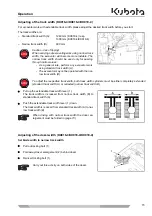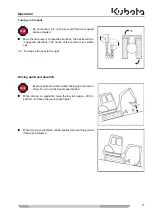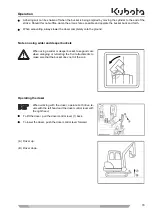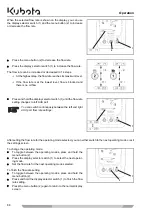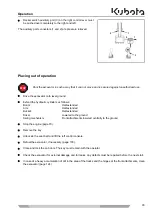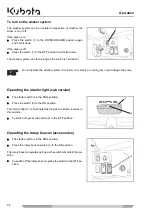
Operation
84
!
Start the engine (page 68) and keep it at idle speed until the operating temperature has been reached.
!
When operating the right pedal part (figure / ) there is an oil
flow at the connector (figure below/1).
!
When operating the left pedal part (figure / ) there is an oil
flow at the connector (figure below/2).
1.
Connector for right pedal part
2.
Connector for left pedal part
Operating of the auxiliary port (KX019-4)
The auxiliary port serves for operating attachments.
The auxiliary port pedal (1) can be protected against
unintentional operating by turning the locking flap (2).
If the auxiliary port pedal is not used, the locking flap
must be folded in.
Only implements approved by KUBOTA may be used. The implements must be operated in accord-
ance with the operating instructions supplied with them.
With the use of a breaker or another attachment for demolition work, where material (e.g. asphalt) is
removed and can uncontrollably sputter away, personal protective equipment is absolutely to be worn
(safety shoes, safety helmet, eye protection, ear protection and if necessary facial mask). The use of
a gravel guard (front protective grid) is recommended. For excavation work with a cab, the front win-
dow must be closed, in addition. For demolition (according to EN 474-1, Annex G), e.g. tearing down
walls, the corresponding protective equipment is required (e.g. gravel guard).
For auxiliary port specifications, see the "Specifications" section" (page 39).
Make sure that, before carrying out the activities in the auxiliary port connectors, the pressure relief
of the hydraulic equipment (page 91) and the auxiliary port connectors (page 92) has been carried
out. Depending on the operation setting, the return change valve has to be set to the appropriate
position (page 91).
The auxiliary ports may only be activated when an implement is attached.
If the auxiliary port has not been used for a longer time, dirt particles could have accumulated at the
connectors of the conduits. Before installing the implement, drain approx. 0.1 L of hydraulic oil at
each port.
Catch the drained hydraulic oil in a container and discard it in accordance with the valid environmen-
tal regulations.
STOP
STOP
STOP




